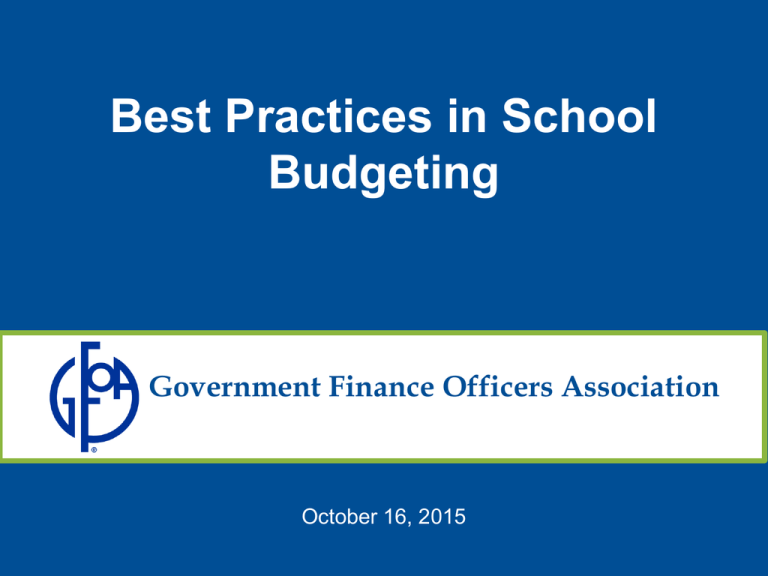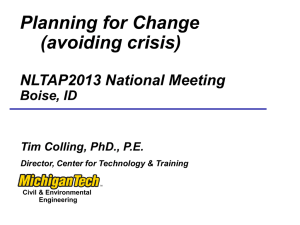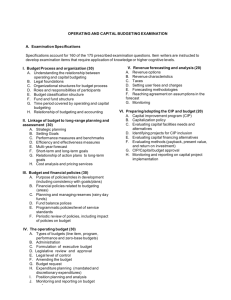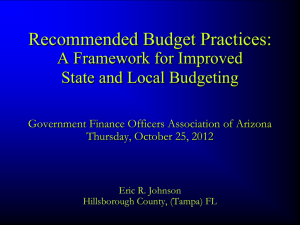Best Practices in School Budgeting
advertisement

Best Practices in School Budgeting Government Finance Officers Association October 16, 2015 Project Development Best Practices in School Budgeting developed by GFOA in conjunction with the Smarter School Spending website with input of several districts and other experts Smarter School Spending developed in partnership with four districts working closely with consultants on their budget process (http://smarterschoolspending.org/) Award for Best Practices in School Budgeting is a new GFOA budget award based on the Best Practices in School Budgeting Alliance for Excellence in School Budgeting is an early adopter group of 35 districts formed by GFOA to aide in implementing the new Best Practices Current Budget Process “Traditional” Budget Model • Limited resources drive spending plan • More reactionary than pro-active • Recent hard times have limited ability to effectively plan multi-year strategies Budget process needs better alignment with student achievement • Some efforts have been made • May not be sustainable Proposed New Process Best Practices in School Budgeting and Smarter School Spending • Pro-active and modernized approach • Alignment of scarce resources to student outcomes • Credibility oContinuous improvement principles oAcademic Return on Investment (A-ROI) oStrategic Finance Plan Best Practices in School Budgeting Focus on 5 major areas: 1. Plan and Prepare 2. Set Instructional Priorities 3. Pay for Priorities 4. Implement Plan 5. Ensure Sustainability Smarter School Spending Smarter School Spending (SSS) website was developed in conjunction with the Best Practices in School Budgeting SSS contains free information, tools, and an on-line forum In process of re-design to enhance search feature and improve user interface www.smarterschoolspending.org Example of SSS Tools GFOA’s Award for Best Practices in School Budgeting New award centered on the core principles of the Best Practices in School Budgeting Award will be phased in beginning with the fiscal years beginning in calendar year 2017 FY18 for those on a July 1 – June 30 fiscal year Basic process for new Award similar to other GFOA awards with an application process and peer review, but will also include: • Applicant interview • Submission of supplementary materials to detail budget process How are they related? Guidelines Best Practices Award Smarter School Spending Core Concepts Plan and Prepare Set Instructional Priorities Pay for Priorities Implement Plan Ensure Sustainability Resources Peer Review Alliance Members AZ CA Amphitheater Public Schools Hayward Unified School District Pomona Unified School District Santa Ana Unified School District Tracy Unified School District CO Boulder Valley School District Moffat County School District FL Lake County Schools Miami-Dade County Public Schools GA Fulton County School System IL St. Charles Community Unit School District 303 IA Des Moines Public Schools KY Fayette County Public Schools LA DeSoto Parish School System MD Howard County Public School System MI St. Johns Public Schools Traverse City Area Public Schools NE Beatrice Public Schools NJ NY OH OR PA TX VA WA WI Elizabeth Public Schools Rochester City School District Bexley City School District Columbus City Schools Dayton City School District Beaverton School District North Bend School District Portland Public Schools (OR) Tigard-Tualatin School District Willamette Education Service District Upper Moreland School District DeSoto Independent School District Wylie Independent School District Goochland County Public Schools Hanover County Public Schools Bellevue School District School District of Fort Atkinson 1. Plan and Prepare A. Develop Principles and Policies to Guide the Budget Process B. Establish a Partnership between the Finance and Instructional Leaders C. Analyze Current Levels of Student Learning D. Identify Communications Strategy 1D. Identify Communications Strategy Communication Strategy Components: • Process Overview • Stakeholder Engagement • Explanation of decisions Implement Communication Strategy • • • • Identify the messengers Identify target audience and tailor messages Select communication channels Gather feedback and adjust Communications Strategy Starting Point Be able to articulate: • Why the district is undertaking the smarter school spending journey • How the district is going to get to where it wants to go • What are people in the district being asked to do? Try an Elevator Speech “We will never have all the funding we need and we are not delivering the outcomes for our students that they deserve. So it’s important that our budget process helps us to spend money in ways that have the largest impact for our students. We are adopting a national best practices framework that will make it possible for us to improve in three ways: we will increase the voice of educators in the budget development; we will be able to network with other districts; we will make greater use of data and review of outcomes. We will develop a budget that reflects what our community needs and wants.” From an Alliance Budget Director Why? How? What? Why? We will never have all the funding we need and we are not delivering the outcomes for our students that they deserve. How? We are adopting a national best practices framework that will make it possible for us to improve in three ways: we will increase the voice of educators in the budget development; we will be able to network with other districts; we will make greater use of data and review of outcomes. What? We will develop a budget that reflects what our community needs and wants. 2. Set Instructional Priorities A. Develop Goals B. Identify Root Cause of Gap between Goal and Current State C. Research and Develop Potential Instructional Priorities D. Evaluate Choices between Instructional Priorities 2A. Develop Goals Format for Goals – SMARTER Framework: • • • • • • • Specific - precise outcome or result Measureable - verifiable, ideally quantifiable Achievable - grounded in reality Relevant - focused on student achievement Time-bound - short and long-term objectives Exciting - reach for ambitious improvement Resourced - finances aligned with goals Example: Lake County Schools, Florida Major Goal: Immediate Investment in Struggling Specific - Adds Precision Students to the Major Goal Sub-Goal: ELL Students. Fund programs aimed at closing the achievement gap of English Language Learner (ELL) students Relevant – says why this goal matters What is the need? LCS spends less on ELL students than comparison districts. The LCS ELL population is growing steadily as the student achievement rates continue to be low Example: Lake County Schools, Florida Achievable What will the District do? Clear path Determine programming options laid out Compare options by potential A-ROI Select highest return option(s) Resourced – Est. cost for budget What will it cost? Year 1 $1 million Year 2 $1 million Year 3 $1 million Measureable, Time-bound, & Exciting What gains does the district expect? Measure ELL Grad. Rate Act. Act. ‘12 ‘13 61% 57% Act. Goal Goal Goal ‘14 ’15 ‘16 ’17 62% 70% 80% 90% Develop Goals Additional points to consider: • Assess the District’s strategic environment • Set SMARTER goals for multi-year districtwide improvement • Understand baseline performance at the school level • Set school site goals 3. Pay for Priorities A. Apply Cost Analysis to the Budget Process B. Evaluate & Prioritize Expenditures to Enact the Instructional Priorities 3A. Apply Cost Analysis to the Budget Process Staffing Analysis • Analyze staffing by programmatic elements, based on school site Cost of Service Analysis • Fully Loaded Cost of Compensation • Per Unit Costs • Cost Effectiveness Measurements S22 S23 Staffing Analysis – Further Detail Analyze staff by school site Also group staff by major functions or programs they support, examples include: • • • • • • • Teachers of core subjects Specialty teachers Instructional facilitators/coaches. Tutors Teachers for English Language Learner (ELL) students. Teachers for special education. Pupil support staff, including guidance counselors, nurses, social workers, etc. • Other support and administrative personnel Staffing Analysis – Points to Consider Additional practices to incorporate into a staffing analysis include: • Identify a clear analytical question to be answered • Use actual compensation – not average compensation • Develop a policy on how to account for centralized personnel – staff providing direct services at schools should be in a school’s budget • Include all staff – not just general operating funded staff • Consider analyzing actual time teaching – analyze actual time teachers spend with students S24 4. Implement Plan A. Develop a Strategic Financial Plan B. Develop a Plan of Action C. Allocate Resources to Individual School Sites D. Develop Budget Document 4D. Develop Budget Document Fundamental Organization of the Budget: • • • • • The Challenges Goals – SMARTER framework Strategies and programs Financial Plan Risks to long-range financial sustainability Source: Coconino Community College FY15 Budget Book Tell the organization’s “story” Challenges – outline the most important issues that the organization is facing Budget Document – Other Areas to Include Long-Range Financial Sustainability: • Long-range enrollment projections • Long-range financial projections • Risk analysis Additional Special Issues/Considerations: • • • • Include all funds Demonstrate transparency in spending Use true program accounting judiciously Provide context 5. Ensure Sustainability A. Put the Strategies into Practice and Evaluate Results Next Steps GFOA is recruiting for the second iteration of the Alliance for Excellence in School Budgeting in implementing the Best Practices in School Budgeting • Kick off late spring/early summer 2016 • Benefits of participating in the ‘Early Adopter’ group include: o Hands on meetings o Access to ‘eLearning’ modules on each of Best Practices in School Budgeting • If interested, apply at: http://www.gfoa.org/alliance-excellenceschool-budgeting Also - several upcoming 2 day trainings available: • January 12 & 13 - Orange County, CA • February 9 & 10 - Ft. Lauderdale, FL • March 8 & 9 – Denver, CO More about the GFOA 18,000 member non-profit organization serving state and local financial professionals across the US and Canada Provide best practices and guidelines on a broad array of financial related topics, including: • • • • • • • Accounting & Financial Reporting Budgeting & Financial Planning Debt Management Financial Management Pension & Benefit Administration Technology Treasury Management Also, provide consulting services on broad array of topics and other award programs for financial reporting, including audits Questions? Contact: Matt Bubness, Manager Government Finance Officers Association Research & Consulting Center mbubness@gfoa.org 312-578-2267






